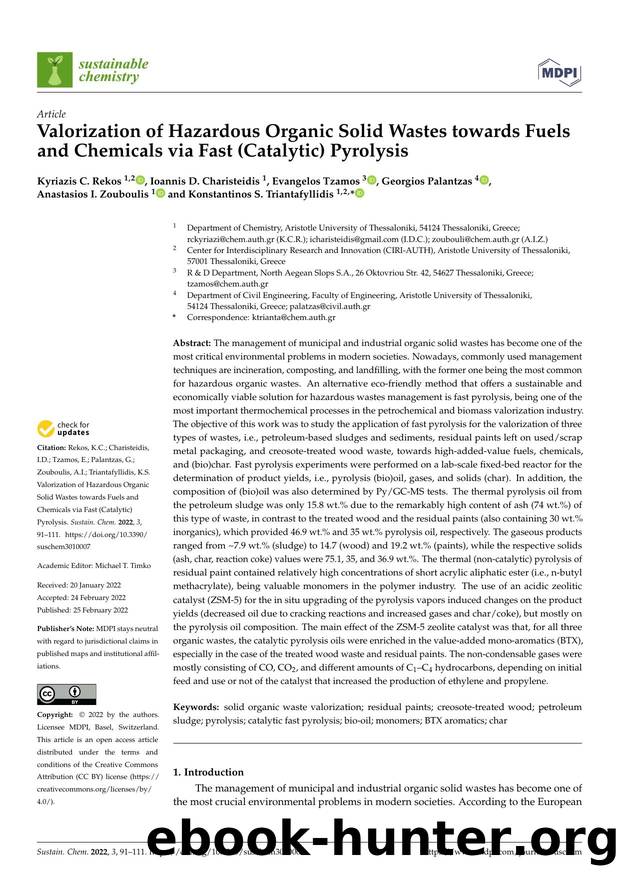Valorization of Hazardous Organic Solid Wastes towards Fuels and Chemicals via Fast (Catalytic) Pyrolysis by unknow

Author:unknow
Format: pdf
Tags: The management of municipal and industrial organic solid wastes has become one of the most critical environmental problems in modern societies. Nowadays, commonly used management techniques are incineration, composting, and landfilling, with the former one being the most common for hazardous organic wastes. An alternative eco-friendly method that offers a sustainable and economically viable solution for hazardous wastes management is fast pyrolysis, being one of the most important thermochemical processes in the petrochemical and biomass valorization industry. The objective of this work was to study the application of fast pyrolysis for the valorization of three types of wastes, i.e., petroleum-based sludges and sediments, residual paints left on used/scrap metal packaging, and creosote-treated wood waste, towards high-added-value fuels, chemicals, and (bio)char. Fast pyrolysis experiments were performed on a lab-scale fixed-bed reactor for the determination of product yields, i.e., pyrolysis (bio)oil, gases, and solids (char). In addition, the composition of (bio)oil was also determined by Py/GC-MS tests. The thermal pyrolysis oil from the petroleum sludge was only 15.8 wt.% due to the remarkably high content of ash (74 wt.%) of this type of waste, in contrast to the treated wood and the residual paints (also containing 30 wt.% inorganics), which provided 46.9 wt.% and 35 wt.% pyrolysis oil, respectively. The gaseous products ranged from ~7.9 wt.% (sludge) to 14.7 (wood) and 19.2 wt.% (paints), while the respective solids (ash, char, reaction coke) values were 75.1, 35, and 36.9 wt.%. The thermal (non-catalytic) pyrolysis of residual paint contained relatively high concentrations of short acrylic aliphatic ester (i.e., n-butyl methacrylate), being valuable monomers in the polymer industry. The use of an acidic zeolitic catalyst (ZSM-5) for the in situ upgrading of the pyrolysis vapors induced changes on the product yields (decreased oil due to cracking reactions and increased gases and char/coke), but mostly on the pyrolysis oil composition. The main effect of the ZSM-5 zeolite catalyst was that, for all three organic wastes, the catalytic pyrolysis oils were enriched in the value-added mono-aromatics (BTX), especially in the case of the treated wood waste and residual paints. The non-condensable gases were mostly consisting of CO, CO2, and different amounts of C1–C4 hydrocarbons, depending on initial feed and use or not of the catalyst that increased the production of ethylene and propylene., solid organic waste valorization; residual paints; creosote-treated wood; petroleum sludge; pyrolysis; catalytic fast pyrolysis; bio-oil; monomers; BTX aromatics; char
Download
This site does not store any files on its server. We only index and link to content provided by other sites. Please contact the content providers to delete copyright contents if any and email us, we'll remove relevant links or contents immediately.
What's Done in Darkness by Kayla Perrin(25507)
Shot Through the Heart: DI Grace Fisher 2 by Isabelle Grey(18227)
Shot Through the Heart by Mercy Celeste(18169)
The Fifty Shades Trilogy & Grey by E L James(17783)
The 3rd Cycle of the Betrayed Series Collection: Extremely Controversial Historical Thrillers (Betrayed Series Boxed set) by McCray Carolyn(13197)
The Subtle Art of Not Giving a F*ck by Mark Manson(12924)
Scorched Earth by Nick Kyme(11843)
Stepbrother Stories 2 - 21 Taboo Story Collection (Brother Sister Stepbrother Stepsister Taboo Pseudo Incest Family Virgin Creampie Pregnant Forced Pregnancy Breeding) by Roxi Harding(11062)
Drei Generationen auf dem Jakobsweg by Stein Pia(10223)
Suna by Ziefle Pia(10188)
Scythe by Neal Shusterman(9271)
International Relations from the Global South; Worlds of Difference; First Edition by Arlene B. Tickner & Karen Smith(8625)
Successful Proposal Strategies for Small Businesses: Using Knowledge Management ot Win Govenment, Private Sector, and International Contracts 3rd Edition by Robert Frey(8426)
This is Going to Hurt by Adam Kay(7713)
Dirty Filthy Fix: A Fixed Trilogy Novella by Laurelin Paige(6461)
He Loves Me...KNOT by RC Boldt(5809)
How to Make Love to a Negro Without Getting Tired by Dany LaFerrière(5390)
Interdimensional Brothel by F4U(5312)
Thankful For Her by Alexa Riley(5174)
